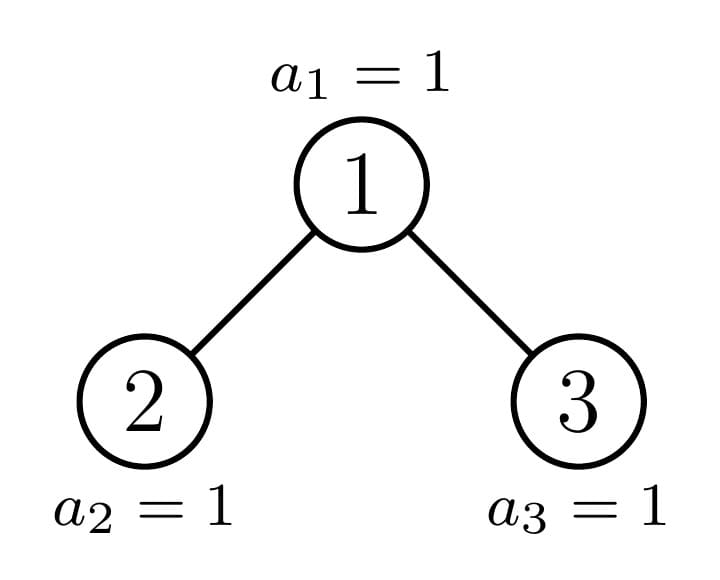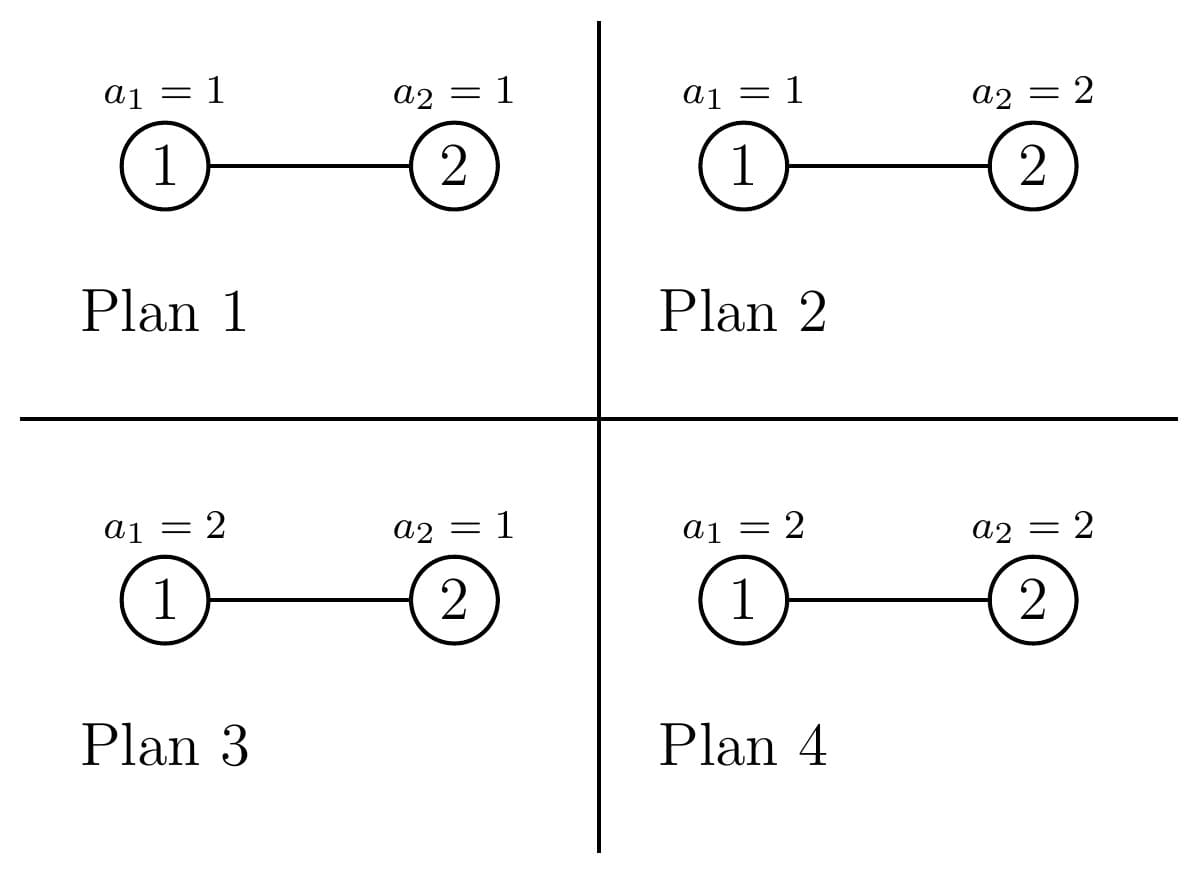310673: CF1868C. Travel Plan
Description
During the summer vacation after Zhongkao examination, Tom and Daniel are planning to go traveling.
There are $n$ cities in their country, numbered from $1$ to $n$. And the traffic system in the country is very special. For each city $i$ ($1 \le i \le n$), there is
- a road between city $i$ and $2i$, if $2i\le n$;
- a road between city $i$ and $2i+1$, if $2i+1\le n$.
Making a travel plan, Daniel chooses some integer value between $1$ and $m$ for each city, for the $i$-th city we denote it by $a_i$.
Let $s_{i,j}$ be the maximum value of cities in the simple$^\dagger$ path between cities $i$ and $j$. The score of the travel plan is $\sum_{i=1}^n\sum_{j=i}^n s_{i,j}$.
Tom wants to know the sum of scores of all possible travel plans. Daniel asks you to help him find it. You just need to tell him the answer modulo $998\,244\,353$.
$^\dagger$ A simple path between cities $x$ and $y$ is a path between them that passes through each city at most once.
InputThe first line of input contains a single integer $t$ ($1\le t\le 200$) — the number of test cases. The description of test cases follows.
The only line of each test case contains two integers $n$ and $m$ ($1\leq n\leq 10^{18}$, $1\leq m\leq 10^5$) — the number of the cities and the maximum value of a city.
It is guaranteed that the sum of $m$ over all test cases does not exceed $10^5$.
OutputFor each test case output one integer — the sum of scores of all possible travel plans, modulo $998\,244\,353$.
ExampleInput5 3 1 2 2 10 9 43 20 154 147Output
6 19 583217643 68816635 714002110Note
In the first test case, there is only one possible travel plan:

Path $1\rightarrow 1$: $s_{1,1}=a_1=1$.
Path $1\rightarrow 2$: $s_{1,2}=\max(1,1)=1$.
Path $1\rightarrow 3$: $s_{1,3}=\max(1,1)=1$.
Path $2\rightarrow 2$: $s_{2,2}=a_2=1$.
Path $2\rightarrow 1\rightarrow 3$: $s_{2,3}=\max(1,1,1)=1$.
Path $3\rightarrow 3$: $s_{3,3}=a_3=1$.
The score is $1+1+1+1+1+1=6$.
In the second test case, there are four possible travel plans:

Score of plan $1$: $1+1+1=3$.
Score of plan $2$: $1+2+2=5$.
Score of plan $3$: $2+2+1=5$.
Score of plan $4$: $2+2+2=6$.
Therefore, the sum of score is $3+5+5+6=19$.
Output
在高考后的暑假,Tom和Daniel计划去旅行。他们的国家有n个城市,编号从1到n。每个城市i(1≤i≤n)有以下两条路:
- 如果2i≤n,则有一条路连接城市i和2i;
- 如果2i+1≤n,则有一条路连接城市i和2i+1。
Daniel为每个城市选择一个介于1和m之间的整数值,记为ai。
设si,j是城市i和j之间简单路径上的城市的最大值。旅行计划的成绩是所有可能的si,j之和。
Tom想要知道所有可能的旅行计划的成绩之和。你需要帮助Daniel找到这个值,结果对998,244,353取模。
输入输出数据格式:
输入:
- 第一行包含一个整数t(1≤t≤200),表示测试用例的数量。
- 每个测试用例包含一行,有两个整数n和m(1≤n≤10^18,1≤m≤10^5),分别表示城市的数量和城市的最大值。
- 所有测试用例的m之和不超过10^5。
输出:
- 对于每个测试用例,输出一个整数,表示所有可能的旅行计划的成绩之和,对998,244,353取模。
示例:
输入:
5
3 1
2 2
10 9
43 20
154 147
输出:
6
19
583217643
68816635
714002110
注意:
在第一个测试用例中,只有一种可能的旅行计划:
路径1→1: s1,1=a1=1。
路径1→2: s1,2=max(1,1)=1。
路径1→3: s1,3=max(1,1)=1。
路径2→2: s2,2=a2=1。
路径2→1→3: s2,3=max(1,1,1)=1。
路径3→3: s3,3=a3=1。
成绩是1+1+1+1+1+1=6。
在第二个测试用例中,有四种可能的旅行计划:
计划1的成绩:1+1+1=3。
计划2的成绩:1+2+2=5。
计划3的成绩:2+2+1=5。
计划4的成绩:2+2+2=6。
因此,成绩之和是3+5+5+6=19。题目大意: 在高考后的暑假,Tom和Daniel计划去旅行。他们的国家有n个城市,编号从1到n。每个城市i(1≤i≤n)有以下两条路: - 如果2i≤n,则有一条路连接城市i和2i; - 如果2i+1≤n,则有一条路连接城市i和2i+1。 Daniel为每个城市选择一个介于1和m之间的整数值,记为ai。 设si,j是城市i和j之间简单路径上的城市的最大值。旅行计划的成绩是所有可能的si,j之和。 Tom想要知道所有可能的旅行计划的成绩之和。你需要帮助Daniel找到这个值,结果对998,244,353取模。 输入输出数据格式: 输入: - 第一行包含一个整数t(1≤t≤200),表示测试用例的数量。 - 每个测试用例包含一行,有两个整数n和m(1≤n≤10^18,1≤m≤10^5),分别表示城市的数量和城市的最大值。 - 所有测试用例的m之和不超过10^5。 输出: - 对于每个测试用例,输出一个整数,表示所有可能的旅行计划的成绩之和,对998,244,353取模。 示例: 输入: 5 3 1 2 2 10 9 43 20 154 147 输出: 6 19 583217643 68816635 714002110 注意: 在第一个测试用例中,只有一种可能的旅行计划: 路径1→1: s1,1=a1=1。 路径1→2: s1,2=max(1,1)=1。 路径1→3: s1,3=max(1,1)=1。 路径2→2: s2,2=a2=1。 路径2→1→3: s2,3=max(1,1,1)=1。 路径3→3: s3,3=a3=1。 成绩是1+1+1+1+1+1=6。 在第二个测试用例中,有四种可能的旅行计划: 计划1的成绩:1+1+1=3。 计划2的成绩:1+2+2=5。 计划3的成绩:2+2+1=5。 计划4的成绩:2+2+2=6。 因此,成绩之和是3+5+5+6=19。